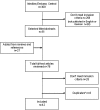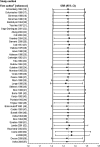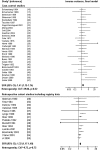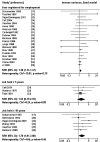Bladder cancer among hairdressers: a meta-analysis
- PMID: 20447989
- PMCID: PMC2981018
- DOI: 10.1136/oem.2009.050195
Bladder cancer among hairdressers: a meta-analysis
Abstract
Background: Occupational risks for bladder cancer in hairdressers by using hair products have been examined in many epidemiological studies. But owing to small sample sizes of the studies and the resulting lack of statistical power, the results of these studies have been inconsistent and significant associations have rarely been found.
Methods: We conducted a meta-analysis to determine summary risk ratios (SRRs) for the risk of bladder cancer among hairdressers. Studies were identified by a MEDLINE, EMBASE, CENTRAL search and by the reference lists of articles/relevant reviews. Statistical tests for publication bias and for heterogeneity as well as sensitivity analysis were applied. In addition, the study quality and the risk of bias were assessed using six criteria.
Results: 42 studies were included and statistically significantly increased risks around 1.3-1.7 were found for all but one analysis. The SRR increased with duration of employment from 1.30 (95% CI 1.15 to 1.48) for 'ever registered as hairdresser' to 1.70 (95% CI 1.01 to 2.88) for 'job held > or = 10 years'. No difference was found between the risk for smoking-adjusted data (SRR 1.35, 95% CI 1.13 to 1.61) and no adjustment (SRR 1.33, 95% CI 1.18 to 1.50). Studies assessed as being of high quality (n=11) and of moderate quality (n=31) showed similar SRRs. There was no evidence of publication bias or heterogeneity in all analyses.
Conclusion: In summary, our results showed an increased and statistically significant risk for bladder cancer among hairdressers, in particular for hairdressers in jobs held > or = 10 years. Residual confounding by smoking cannot be totally ruled out. Because of the long latency times of bladder cancer it remains an open question whether hairdressers working prior to 1980 and after 1980, when some aromatic amines were banned as hair dye ingredients, have the same risk for bladder cancer.
Conflict of interest statement
Figures




Similar articles
-
The debate on carcinogenicity of permanent hair dyes: new insights.Crit Rev Toxicol. 2007;37(6):521-36. doi: 10.1080/10408440701385671. Crit Rev Toxicol. 2007. PMID: 17661215 Review.
-
A meta-analysis on the association between bladder cancer and occupation.Scand J Urol Nephrol Suppl. 2008 Sep;(218):64-78. doi: 10.1080/03008880802325192. Scand J Urol Nephrol Suppl. 2008. PMID: 18815919 Review.
-
Cancer risks in hairdressers: assessment of carcinogenicity of hair dyes and gels.Int J Cancer. 2003 May 20;105(1):108-12. doi: 10.1002/ijc.11040. Int J Cancer. 2003. PMID: 12672039
-
Epidemiological evidence on hair dyes and the risk of cancer in humans.Eur J Cancer Prev. 1995 Feb;4(1):31-43. doi: 10.1097/00008469-199502000-00003. Eur J Cancer Prev. 1995. PMID: 7728096 Review.
-
Bladder cancer risk and personal hair dye use.Int J Cancer. 2004 Apr 20;109(4):581-6. doi: 10.1002/ijc.11729. Int J Cancer. 2004. PMID: 14991581
Cited by
-
Modifiable risk factors for the prevention of bladder cancer: a systematic review of meta-analyses.Eur J Epidemiol. 2016 Sep;31(9):811-51. doi: 10.1007/s10654-016-0138-6. Epub 2016 Mar 21. Eur J Epidemiol. 2016. PMID: 27000312 Free PMC article.
-
Constitutional and occupational risk factors associated with bladder cancer.Actas Urol Esp. 2013 Sep;37(8):513-22. doi: 10.1016/j.acuro.2013.01.001. Epub 2013 May 9. Actas Urol Esp. 2013. PMID: 23664103 Free PMC article. Review.
-
Melanin-mimetic multicolor and low-toxicity hair dye.RSC Adv. 2019 Oct 18;9(58):33617-33624. doi: 10.1039/c9ra07466j. eCollection 2019 Oct 18. RSC Adv. 2019. PMID: 35528905 Free PMC article.
-
Cosmetics and Cancer: Adverse Event Reports Submitted to the Food and Drug Administration.JNCI Cancer Spectr. 2018 Jun 20;2(2):pky012. doi: 10.1093/jncics/pky012. eCollection 2018 Apr. JNCI Cancer Spectr. 2018. PMID: 31360845 Free PMC article.
-
Hair dye use and prostate cancer risk: A prospective analysis in the Alpha-Tocopherol, Beta-Carotene Cancer Prevention Study cohort.Cancer. 2022 Mar 15;128(6):1260-1266. doi: 10.1002/cncr.34035. Epub 2021 Nov 19. Cancer. 2022. PMID: 34797564 Free PMC article.
References
-
- Bolt HM, Golka K. The debate on carcinogenicity of permanent hair dyes: new insights. Crit Rev Toxicol 2007;37:521–36 - PubMed
-
- Golka K, Schops W, Kierfeld G, et al. [Urothelial diseases as an occupational disease]. Versicherungsmedizin 1994;46:158–61 - PubMed
-
- Weistenhofer W, Blaszkewicz M, Bolt HM, et al. N-acetyltransferase-2 and medical history in bladder cancer cases with a suspected occupational disease (BK 1301) in Germany. J Toxicol Environ Health A 2008;71:906–10 - PubMed
-
- Bolt HM, Golka K. Occupational cancer—burdens of the past or actual threat? Dtsch Med Wochenschr 2007;132:133–4 - PubMed
Publication types
MeSH terms
Substances
LinkOut - more resources
Full Text Sources
Medical
